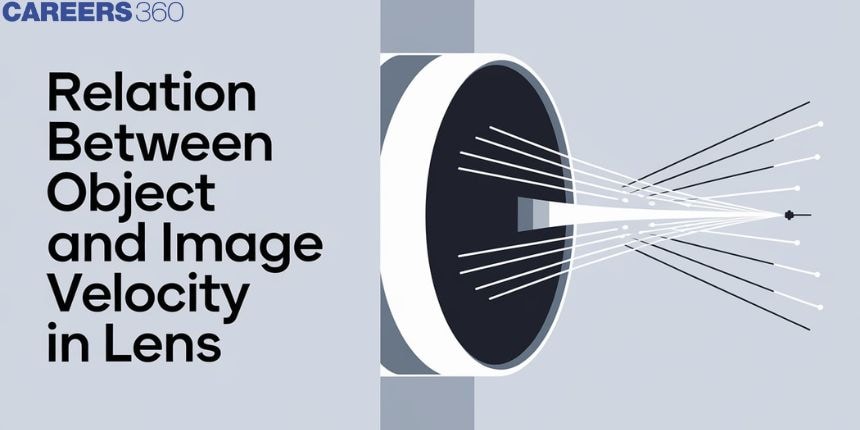Relation Between Object And Image Velocity In Lens
The relationship between object and image velocity in lenses is a fundamental concept in optics that describes how the speed of an object's movement affects the speed and position of the resulting image. This dynamic interplay is crucial for understanding how lenses capture and project moving objects, impacting fields such as photography, microscopy, and filmography. When an object moves, the image formed by the lens shifts accordingly, and this relationship can be analyzed through concepts like magnification and lens equations. In real life, this principle is essential for high-speed photography, where precise control over image formation is needed to capture fast-moving subjects clearly. Additionally, it plays a key role in the design of optical instruments and imaging systems, ensuring accurate representation of motion in various applications.
This Story also Contains
- Relation between Object and Image Velocity in Lens
- Solved Examples Based on Relation Between Object and Image Velocity in Lens
- Summary

Relation between Object and Image Velocity in Lens
The relation between object and image velocity in lenses describes how the speed at which an object moves affects the speed at which its image shifts through a lens. This relationship is crucial for understanding the dynamics of moving objects in various optical systems. Now we steady cases one by one and understand the concept
Case 1: When the Object is Moving Along the Principal Axis
When an object moves along the principal axis of a lens, the velocity of the image formed by the lens is directly related to the velocity of the object. This scenario is fundamental in optics, particularly for understanding dynamic systems where objects or images are in motion.

As we have learned the following equation
After differentiation
Case 2: When the Object is Moving Perpendicular to the Principal Axis
When an object moves perpendicular to the principal axis of a lens, the relationship between the object's velocity and the image's velocity involves more complex interactions, as the image shifts differently compared to when the object moves along the principal axis.

After differentiation
Here, m = magnification
u = Position of object
$\vec{V}$ = Velocity vector
Recommended Topic Video
Solved Examples Based on Relation Between Object and Image Velocity in Lens
Example 1: An object is at a distance of 20m from a convex lens of focal length 0.3m. The lens forms an image of the object. If the object moves away from the lens at a speed of 5m/s, the speed and direction of the image will be:
1)
2)
3)
4)
Solution:
From the lens formula
The velocity of image w.r.t. lens
and direction is the same as that of the object
Hence, the answer is the option (2).
Example 2: An object is kept at 40 cm from a concave mirror of a focal length of 20 cm. If the object starts moving along perpendicular to the principle axis with 6 cm/s then the velocity of the image is :
1) 3 cm/s
2) 4 cm/s
3) 6 cm/s
4) 8 cm/s
Solution:
If the object is moving perpendicular to the principal axis
wherein

Hence, the answer is the option (3).
Example 3: The velocity of a point is

1) 14 cm/s in left direction
2) 14 cm/s in right direction
3) 7 cm/s in left direction
4) 7 cm/s in the right direction
Solution:
The velocity of the image w.r.t. lens along the principal axis is given by
Example 4: A point object is moving with a speed v before an arrangement of two mirrors as shown in the figure.

Find the velocity of the image in the mirror
1)
2)
3)
4)
Solution:
The velocity of the image,

Hence, the answer is the option (1).
Example 5: A mirror with a radius of curvature of 20cm and an object which is placed at a distance of 15cm are both moving with velocities of 1ms-1 and 10ms-1. The velocity of the image in this situation is
1) 40 cm/s
2) 44 cm/s
3) 45 cm/s
4) 30 cm/s
Solution:
Relation between object and image velocity if the object is moving along the principal axis
wherein

$\therefore$ velocity of the image is 45 cm/s
Hence, the answer is the option (3).
Summary
The relationship between object and image velocity in lenses is crucial for understanding how movement affects image formation. When an object moves along the principal axis of a lens, the image velocity is directly related to the object's velocity, with changes in object distance influencing the image speed and direction. When the object moves perpendicular to the principal axis, the image velocity depends on the magnification and the direction of the object's movement. These principles are vital in practical applications such as photography and microscopy, where accurate motion tracking and image clarity are essential.